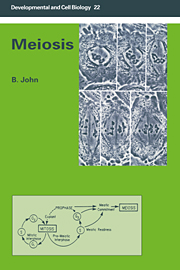Book contents
- Frontmatter
- Contents
- Acknowledgements
- Prologue
- 1 Introduction – multiplication and division
- 2 Modes of meiosis
- 3 Occurrence and timing of meiosis
- 4 Events and mechanisms of meiosis
- 5 Chromosome disjunction
- 6 The genetic control of meiosis
- 7 Sequences and consequences of meiosis
- 8 Evolutionary aspects of meiosis
- Postlogue
- References
- Index
Postlogue
Published online by Cambridge University Press: 21 January 2010
- Frontmatter
- Contents
- Acknowledgements
- Prologue
- 1 Introduction – multiplication and division
- 2 Modes of meiosis
- 3 Occurrence and timing of meiosis
- 4 Events and mechanisms of meiosis
- 5 Chromosome disjunction
- 6 The genetic control of meiosis
- 7 Sequences and consequences of meiosis
- 8 Evolutionary aspects of meiosis
- Postlogue
- References
- Index
Summary
There's no difficulty in recognising the obvious. One should be slower to believe it.
P. D. JamesEvery aspect of meiosis that we have considered is evidently beset with both controversial and unresolved issues. Far from having solved longstanding problems, the new information now available to us has simply served to put them into a different context. It is for this reason that we still lack a complete theory of meiosis.
Over and above individual issues there are two rather more fundamental features of meiosis which are also in need of a solution. The first of these is a developmental matter. The meiocyte is simply a specialized cell with a distinctive pattern of cytodifferentiation though, unlike most other categories of cytodifferentiation, that of the meiocyte principally involves changes in the chromosomes themselves rather than chromosome-induced changes in the cell cytoplasm (Stern & Hotta, 1984). In S. pombe, cell-type determination is controlled by a class of master regulatory, mat, genes, whereas cell differentiation is regulated by protein kinases (see Section 4A). These two systems are associated through the mei-3+ gene which is transcriptionally regulated by the mat genes and whose product, in turn, inhibits the ran-1+ protein kinase (McLeod & Beach, 1988). Precisely how the differentiated state of the meiocyte is initiated in other eukaryotes remains unsolved, though the molecular events associated with it are now tolerably well known. Some of them involve the activity of genes, enzymes and proteins available to, and used by, mitotic cells. This includes those genes responsible for such ubiquitous cell products as actins, tubulins and kinetochores, as well as some of the enzymes involved in the replication and recombination of DNA. Meiocyte differentiation also involves novel gene products.
- Type
- Chapter
- Information
- Meiosis , pp. 324 - 327Publisher: Cambridge University PressPrint publication year: 1990



